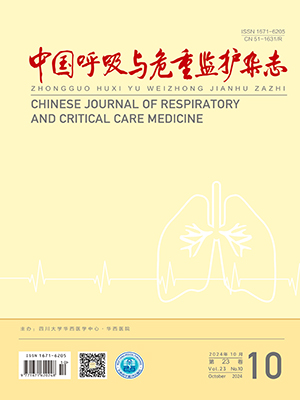| 1. |
Fan E, Villar J, Slutsky AS. Novel approaches to minimize ventilator-induced lung injury. BMC Med, 2013, 11: 85.
|
| 2. |
Fothergill J. Observations on a case published in the last volume of the medical essays, &c. of recovering a man dead in appearance, by distending the lungs with air. Printed at Edinburgh, 1744; by John , Licent. Coll. Med. Lond. 1992.
|
| 3. |
Kuchnicka K, Maciejewski D. Ventilator-associated lung injury. Anaesthesiol Intensive Ther, 2013, 45(3): 164-170.
|
| 4. |
Plataki M, Hubmayr RD. The physical basis of ventilator-induced lung injury. Expert Rev Respir Med, 2010, 4(3): 373-385.
|
| 5. |
Kilickaya O, Gajic O. Initial ventilator settings for critically ill patients. Crit Care, 2013, 17(2): 123.
|
| 6. |
Protti A, Cressoni M, Santini A, et al. Lung stress and strain during mechanical ventilation: any safe threshold?. Am J Respir Crit Care Med, 2011, 183(10): 1354-1362.
|
| 7. |
Houston P. An approach to ventilation in acute respiratory distress syndrome. Can J Surg, 2000, 43(4): 263-268.
|
| 8. |
Nieman GF, Satalin J, Andrews P, et al. Personalizing mechanical ventilation according to physiologic parameters to stabilize alveoli and minimize ventilator induced lung injury. Intensive Care Med Exp, 2017, 5(1): 8-28.
|
| 9. |
Gattinoni L, Pesenti A. The concept of "baby lung". Intensive Care Med, 2005, 31(6): 776-784.
|
| 10. |
Vlahakis NE, Hubmayr RD. Cellular stress failure in ventilator-injured lungs. Am J Respir Crit Care Med, 2005, 171(12): 1328-1342.
|
| 11. |
Dreyfuss D, Saumon G. Ventilator-induced lung injury lessons from experimental studies. Am J Respir Crit Care Med, 1998, 157(1): 294-323.
|
| 12. |
Chiumello D, Carlesso E, Cadringher P, et al. Lung stress and strain during mechanical ventilation for acute respiratory distress syndrome. Am J Respir Crit Care Med, 2008, 178(4): 346-355.
|
| 13. |
Pasin L, Nardelli P, Belletti A, et al. Pulmonary complications after open abdominal aortic surgery: a systematic review and meta-analysis. J Cardiothorac Vasc Anesth, 2017, 31(2): 562-568.
|
| 14. |
Biehl M, Kashiouris MG, Gajic O. Ventilator-induced lung injury: minimizing its impact in patients with or at risk for ARDS. Respir Care, 2013, 58(6): 927-937.
|
| 15. |
Hala MF, Hamed HG. Ventilation and ventilators in the ICU: what every intensivist must know. Curr Anaesth Crit Care, 2006, 17(7): 77-83.
|
| 16. |
Roan E, Waters CM. What do we know about mechanical strain in lung alveoli?. Am J Physiol Lung Cell Mol Physiol, 2011, 301(5): 625-635.
|
| 17. |
Bilek AM, Dee KC, Gaver DP 3rd.. Mechanisms of surface-tension-induced epithelial cell damage in a model of pulmonary airway reopening. J Appl Physiol, 2003, 94(2): 770-783.
|
| 18. |
Curley GF, Laffey JG, Zhang H, et al. Biotrauma and ventilator induced lung injury: clinical implications. Chest, 2016. 150(5): 1109-1117.
|
| 19. |
Slutsky AS, Tremblay LN. Multiple system organ failure. Is mechanical ventilation a contributing factor?. Am J Respir Crit Care Med, 1998, 156(6 Pt 1): 1721-1725.
|
| 20. |
Albaiceta GM, Blanch L. Beyond volutrauma in ARDS: the critical role of lung tissue deformation. Crit Care, 2011, 15(2): 304.
|
| 21. |
Dos Santos CC, Slutsky AS. Invited review: mechanisms of ventilator-induced lung injury: a perspective. J Appl Physiol, 2000, 89(4): 1645-1655.
|
| 22. |
Tremblay L, Valenza F, Ribeiro SP, et al. Injurious ventilatory strategies increase cytokines and c-fos m-RNA expression in an isolated rat lung model. J Clin Invest, 1997, 99(5): 994-952.
|
| 23. |
Quilez ME, Fuster G, Villar J, et al. Injurious mechanical ventilation affects neuronal activation in ventilated rats. Crit Care, 2011, 15(3): R124-R135.
|
| 24. |
Altemeier WA, Sinclair SE. Hyperoxia in the intensive care unit: why more is not always better. Current Opinion in Critical Care, 2007, 13(1): 73-78.
|
| 25. |
Lee PJ, Choi AMK. Pathways of cell signaling in hyperoxia. Free Radical Biol Med, 2003, 35(4): 341-350.
|
| 26. |
Wang Y, Phelan SA, Manevich Y, et al. Transgenic mice overexpressing peroxiredoxin 6 show increased resistance to lung injury in hyperoxia. Am J Respir Cell Mol Bio, 2006, 34(4): 481-486.
|
| 27. |
Pagano A, Donati Y, Métrailler I, et al. Mitochondrial cytochrome c release is a key event in hyperoxia-induced lung injury: protection by cyclosporin A. Am J Physiol Lung Cell Mol Physiol, 2004, 286(2): L275-L283.
|
| 28. |
Wajant H. The Fas signaling pathway: more than a paradigm. Science, 2002, 296(5573): 1635-1636.
|
| 29. |
郑瑞强, 张敏. ARDS 患者呼吸机相关性肺损伤的肺保护策略. 中国呼吸与危重监护杂志, 2014. 13(2):211-215.
|
| 30. |
Eisner MD1, Parsons P, Matthay MA, et al. Plasma surfactant protein levels and clinical outcomes in patients with acute lung injury. Thorax, 2003. 58(11): 983-988.
|
| 31. |
Herasevich V, Tsapenko M, Kojicic M, et al. Limiting ventilator-induced lung injury through individual electronic medical record surveillance. Crit Care Med, 2011, 39(1): 34-39.
|
| 32. |
朱发光. 呼吸机相关性肺损伤的研究进展. 国外医学呼吸系统分册, 2001, 21(1): 50-56.
|
| 33. |
Laffey JG, Kavanagh BP. Ventilation with lower tidal volumes as compared with traditional tidal volumes for acute lung injury.. N Engl J Med, 2000, 343(11): 812.
|
| 34. |
Briel M, Meade M, Mercat A, et al. Higher vs lower positive end-expiratory pressure in patients with acute lung injury and acute respiratory distress syndrome: systematic review and meta-analysis. JAMA, 2010, 303(9): 865-873.
|
| 35. |
严洁, 殷辰俞. w-3 脂肪酸对于大鼠呼吸机相关性肺损伤的预防作用及机制研究. 重庆医学, 2016. 45(14):1896-1899.
|




